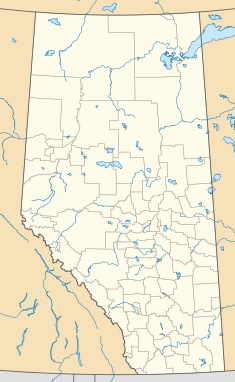Dinosaur Provincial Park
| Dinosaur Provincial Park | |
|---|---|
Alberta Tourism, Parks and Recreation | |
Natural Monument ) | |
| Provincial Park of Alberta | 1955 |
| Type | Natural |
| Criteria | vii, viii |
| Designated | 1979 (3rd session) |
| Reference no. | 71 |
| Country | Canada |
| Region | Europe and North America |
Dinosaur Provincial Park is a
.The park is situated in the
Dinosaur Provincial Park Visitor Centre
The Dinosaur Provincial Park Visitor Centre features exhibits about dinosaurs, fossils, and the geology and natural history of the park. There is a video theatre, fossil prep lab area, and a gift shop. Public programs are offered in the summer.
John Ware's Cabin is a restored early 20th century cabin that was used by
History
Established on June 27, 1955 as part of Alberta's 50th Jubilee Year with the goal of protecting the fossil beds, the first warden was Roy Fowler (1902-1975), a farmer and amateur fossil hunter.
The park was established as a
Until 1985, discoveries made in the park had to be shipped to museums throughout the world for scientific analysis and display, including the Royal Ontario Museum in Toronto in Ontario, the Canadian Museum of Nature in Ottawa in Ontario, and the American Museum of Natural History in New York City, New York State. This changed with the opening of the Royal Tyrrell Museum of Palaeontology 100 kilometres upstream in Midland Provincial Park adjacent to Drumheller.
Nature
The park protects a very complex ecosystem including three communities: prairie grasslands, badlands, and riverside
Geology
The
Paleontology


Dinosaur Provincial Park preserves an extraordinarily diverse group of freshwater vertebrates. Fish include
Plant fossils from the park and surrounding area include
The dinosaurs of the park are astonishingly diverse. They include:
- Leptoceratops sp.
- Centrosaurus apertus
- Coronosaurus brinkmani
- Styracosaurus albertensis
- Pachyrhinosaurus
- Chasmosaurus belli, C. russelli
- Vagaceratops irvinensis
- Corythosaurus casuarius
- Gryposaurus notabilis, G. incurvimanus
- Lambeosaurus lambei, L. magnicristatus
- Prosaurolophus maximus
- Parasaurolophus walkeri
- Daspletosaurus torosus
- Gorgosaurus libratus
- Ornithomimus
- Struthiomimus
- Rativates
- new ornithomimid species A
- Chirostenotes pergracilis
- Chirostenotes elegans
- Chirostenotes collinsi
- Dromaeosaurus albertensis
- Saurornitholestes
- Hesperonychus elizabethae
- ?new dromaeosaur species A
- ?new dromaeosaur species B
- Troodon
- new troodontid species A
Classification Uncertain
- Ricardoestesiagilmorei
Birds such as
IUGS geological heritage site
In respect of it being the 'world's most abundant and diverse dinosaur locality, yielding more than 166 vertebrate taxa, including 51 species of non-avian dinosaurs', the International Union of Geological Sciences (IUGS) included the 'Dinosaur Provincial Park' in its assemblage of 100 'geological heritage sites' around the world in a listing published in October 2022. The organisation defines an IUGS Geological Heritage Site as 'a key place with geological elements and/or processes of international scientific relevance, used as a reference, and/or with a substantial contribution to the development of geological sciences through history.'[5]
Gallery
-
Dinosaur Provincial Park
-
Dinosaur Provincial Park
-
Dinosaur Provincial Park
-
Dinosaur Provincial Park
-
Dinosaur Provincial Park
-
Dinosaur Provincial Park
-
Dinosaur Provincial Park
-
Dinosaur Provincial Park
-
Dinosaur Provincial Park
-
Dinosaur Provincial Park
-
Dinosaur Provincial Park
-
Dinosaur Provincial Park
-
Dinosaur Provincial Park
-
Dinosaur Provincial Park
-
Dinosaur Provincial Park
-
Dinosaur Provincial Park
-
Dinosaur Provincial Park
-
Dinosaur Provincial Park
-
Dinosaur Provincial Park
-
Dinosaur Provincial Park
-
Dinosaur Provincial Park
-
Dinosaur Provincial Park
-
Dinosaur Provincial Park
See also
- List of Alberta provincial parks
- List of Canadian provincial parks
- List of National Parks of Canada
- List of World Heritage Sites in the Americas
References
- ^ "Travel Article: Dinosaur Provincial Park". Archived from the original on 2011-07-18. Retrieved 2009-11-11.
- ^ a b Currie, P.J., and Koppelhus, E.B. (eds). 2005. Dinosaur Provincial Park: A Spectacular Ancient Ecosystem Revealed. Indiana University Press: Bloomington and Indianapolis, 648 p.
- ^ Koppelhus, E.B. 2005. Paleobotany. In: Currie, P.J., and Koppelhus, E.B. (eds), Dinosaur Provincial Park: A Spectacular Ancient Ecosystem Revealed. Indiana University Press: Bloomington and Indianapolis, 131-138.
- ^ Braman, D.R., and Koppelhus, E.B. 2005. Campanian palynomorphs. In: Currie, P.J., and Koppelhus, E.B. (eds), Dinosaur Provincial Park: A Spectacular Ancient Ecosystem Revealed. Indiana University Press: Bloomington and Indianapolis, 101-130.
- ^ "The First 100 IUGS Geological Heritage Sites" (PDF). IUGS International Commission on Geoheritage. IUGS. Retrieved 13 November 2022.
























